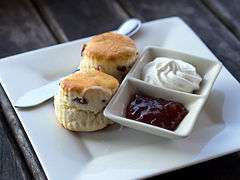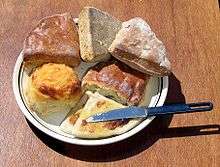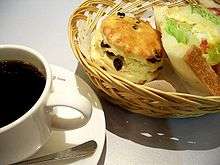Scone
A scone (/skɒn/ or /skoʊn/) is a baked good, usually made of wheat, or oatmeal with baking powder as a leavening agent and baked on sheet pans. A scone is often slightly sweetened and occasionally glazed with egg wash.[1] The scone is a basic component of the cream tea. It differs from teacakes and other types of sweets that are made with yeast. Scones were chosen as the Republic of Ireland representative for Café Europe during the Austrian Presidency of the European Union in 2006, while the United Kingdom chose shortbread.
 | |
| Type | Pastry |
|---|---|
| Place of origin | United Kingdom, Ireland |
| Main ingredients | Wheat, barley, or oatmeal |
Lexicology

The pronunciation of the word within the English-speaking world varies, with some pronouncing it /skɒn/ (rhymes with "swan"),[2] and others /skoʊn/ (rhymes with "tone").[3] The dominant pronunciation differs by area. The pronunciation rhyming with "tone" is strongest in the Midlands and southern Ireland, though seems to have less prominent patches in Cornwall and Essex. The pronunciation rhyming with "swan" is strongest in Northern England and Scotland, although also seems to be the favoured pronunciation in Southern England, Wales, the Home Counties, and East Anglia.[4][5] Natives of the Republic of Ireland and the United States mainly use the /skoʊn/ pronunciation.[6] British dictionaries usually show the /ˈskɒn/ form as the preferred pronunciation, while recognising the /ˈskoʊn/ form.[2]
The difference in pronunciation is alluded to in a poem:
The Oxford English Dictionary reports that the first mention of the word was in 1513. Origin of the word scone is obscure and may, in fact, derive from different sources. That is, the classic Scottish scone and the Dutch schoonbrood or "spoonbread" (very similar to the drop scone); and possibly other, similar and similarly named quick breads, may have made their way onto the British tea table, where their similar names merged into one.
Thus, scone may derive from the Middle Dutch schoonbrood (fine white bread), from schoon (pure, clean) and brood (bread),[9][10] or it may derive from the Scots Gaelic term sgonn meaning a shapeless mass or large mouthful. The Middle Low German term schöne meaning fine bread may also have played a role in the origination of this word. And if the explanation put forward by Sheila MacNiven Cameron be true, the word may also be based on the town of Scone (/skuːn/ (![]()
History
It is believed that historically scones were round and flat, usually as large as a medium-sized plate. It was made and baked on a griddle (or girdle, in Scots), then cut into triangular sections for serving. Today, many would call the large round cake a bannock. In Scotland, the words are often used interchangeably.[12]
When baking powder became available to the masses, scones began to be the oven-baked, well-leavened items we know today.[13] Modern scones are widely available in British bakeries, grocery stores, and supermarkets. A 2005 market report estimated the UK scone market to be worth £64m, showing a 9% increase over the previous five years. The increase is partly due to an increasing consumer preference for impulse and convenience foods.[14]
Scones sold commercially are usually round, although some brands are hexagonal as this shape may be tessellated for space efficiency. When prepared at home, they may take various shapes including triangles, rounds and squares.[15] Baking scones at home is often closely tied to heritage baking. They tend to be made using family recipes rather than recipe books, since it is often a family member who holds the "best" and most-treasured recipe.[16]
Varieties


British scones are often lightly sweetened, but may also be savoury. They frequently include raisins, currants, cheese or dates. In Scotland and Ulster, savoury varieties of scone include soda scones, also known as soda farls, and potato scones, normally known as tattie scones, which resemble small, thin savoury pancakes made with potato flour. Potato scones are most commonly served fried in a full Scottish breakfast or an Ulster fry.


The griddle scone (or "girdle scone" in Scots) is a variety of scone which is cooked on a griddle (or girdle) on the stove top rather than baked in the oven. This usage is also common in New Zealand where scones of all varieties form an important part of traditional colonial New Zealand cuisine.
Other common varieties include the dropped scone, or drop scone, like a pancake, after the method of dropping the batter onto the griddle or frying pan to cook it, and the lemonade scone, which is made with lemonade and cream instead of butter and milk. There is also the fruit scone or fruited scone, which contains currants, sultanas, peel and glacé cherries, which is just like a plain round scone with the fruit mixed into the dough. To achieve lightness and flakiness, scones may be made with cream instead of milk.
In some countries one may also encounter savoury varieties of scone which may contain or be topped with combinations of cheese, onion, bacon, etc.
Scones can be presented with various toppings and condiments, typically butter, jam and cream. Strawberries are also sometimes used.
Regional variations
Australia
Pumpkin scones, made by adding mashed cooked pumpkin to the dough mixture, had increased exposure during the period when Florence Bjelke-Petersen was in the public eye.[17][18] Date scones, which contain chopped dried dates, can also be found in Australia. Another old style of cooking scones, generally in the colder months, is to deep-fry or deep pan-fry them in dripping or oil, when they are called "puftaloons".
Europe
In Hungary, a pastry very similar to the British version exists under the name "pogácsa". The name has been adopted by several neighbouring nations' languages. (E.g. Pogatsche in German.) Pogácsa is almost always savoury and served with varied seasonings and toppings, like dill and cheese.
New Zealand
Cheese scones are a popular snack sold in cafes or tea shops, where they are commonly served toasted with butter.[19] They are featured in the Edmonds Cookery Book and make up a part of kiwiana.
South Africa
Scones are commonly served with clotted cream and jam; grated cheddar cheese is another popular accompaniment.
South America
Scones are quite popular in Argentina as well as Uruguay. They were brought there by Irish, English and Scottish immigrants and by Welsh immigrants in Patagonia (Britons are the third largest foreign community in Argentina).[20] They are usually accompanied by tea, coffee or mate.
United States
Round British scones superficially resemble North American biscuits in appearance, but they have a very different history that is unrelated to the Scottish bannock, and actually North American biscuits have hardtack as a direct ancestor, also known as a "seabiscuit" : this was a type of cracker made of lard and flour that became standard issue to the British Navy under the reign of Elizabeth I. The word "biscuit" is used in part because of its ancestor's name of "seabiscuit," but also because American English already has a word for a dry, sweet baked good, taken from Dutch: cookie.
It was very common for emigrants from England in the 17th century, those who bought passage to the New World through indentured servitude, to have simple meals of wheat warmed over with a milk based gravy.[21] In both cases, liquid was used to soften the often hard-as-nails comestible that would keep for long periods of time, the Royal Navy typically using grog or straight rum.[22]. The hardtack would have been traded in the Thirteen Colonies along with other finished goods, and over time it evolved.
The present day recipe is some combination of buttermilk or milk, plain flour, salt, and butter, margarine, or shortening. They can either be rolled into a dough and cut into rounds to create a flaky texture or, provided more liquid is added, can become a batter that creates "drop biscuits." Other recipes include cheddar cheese to make cheese biscuits. [23] Unlike British scones, in all Southern biscuits, the butter or shortening is room temperature, not cold, and shortening based on cotton seed ( traditionally Crisco) or margarine are acceptable.[16] Either baking powder or bicarbonate soda are the leavening agents and no recipe for Southern biscuits has ever included yeast.
British scones are frequently (but not always) sweet, and served with coffee and tea. For Southern biscuits, however, they were never intended for tea time as there was no such thing as afternoon tea or high tea even in the middle of the Victorian Era for most of the population: the majority of Americans worked sunrise to sunset as farmers, ranch hands, and slaves in the countryside. The rest worked as shopkeepers, tradesmen, or labourers in the cities, with no city yet large enough in population to rival the much more powerful London; Atlanta itself had a population of less than 10,000.[24] New York's population was under a million and would not match the population of London in 1860 until 1900.[25]
Any sugar added is inauthentic and not true to the biscuit's history. During the American Civil War, the nation was hugely divided with the eleven states of the South and the Midwest, Northeast, and California at each other's throats ideologically and quite literally, evidenced by fortification of rivers where many states had natural borders and both Richmond and Washington DC themselves heavily barricaded along the Potomac and James Rivers. Union strategy was to blow up railroad tracks to stymie Confederate supply lines.[26] Getting sugar of any kind was nearly impossible and yeast to leaven bread became scarce; at one point, because of the actions of General Sherman, large swathes of Georgia faced starvation as he burned most of the crops to terrorize the people into yielding to the Union soldiers (and the enormous following of freed slaves) on the march.[27] [28] Improvisation was a must, and so bicarbonate of soda or baking powder became the sole leavening agents used in the recipe for Southern biscuits and forevermore the door was slammed shut on them ever being sweetened.
Today, Southern biscuits are a staple of the cuisine of the American South, served warm and sliced horizontally for breakfast with butter, fruit jam or honey, with tupelo honey or clover honey being the favourites. Southern biscuits are essential to a variation on the breakfast roll that often involves scrambled eggs with tomato, streaky bacon or salty country ham[29]. They are a component of biscuits and gravy, a direct descendant of the same English dish for the poor and eaten for breakfast with bits of breakfast sausage. Biscuits are also eaten at lunch or dinner as an accompaniment to nearly all kinds of American barbecue, fried chicken, Lowcountry cuisine, and are a necessary part of the Southern version of Thanksgiving.
In recent years, scones under that name have begun to appear in coffee houses. They may be sweet, often containing fruit such as blueberries or sultanas, or else such flavorings as cinnamon or chocolate chips. US "scones" are usually actually closer to British Rock cakes. They are heavy, dry and crumbly, usually in a triangular or irregular shape.
In Utah and southern Idaho, the bread products locally called "scones" are similar to Native American frybread or New Orleans beignets and are made from a sweet yeast dough, with buttermilk and baking powder or soda added, and they are fried rather than baked. They are customarily served with butter and either honey or maple syrup.[30]
Cultural references
The plot of Season 10, Episode 3 of Curb Your Enthusiasm[31] involves a heated dispute about the proper texture for scones.
Other usage
In Scots the verb scon means to crush flat or beat with the open hand on a flat surface, and "scon-cap" or "scone-cap" refers to a man's broad flat cap or "bunnet".
In Australia, scone can be a slang term for the head, usually referring to the crown region.
See also
| Wikimedia Commons has media related to Scones. |
| Wikibooks Cookbook has a recipe/module on |
| Look up scone in Wiktionary, the free dictionary. |
References
- Hollywood, Paul. "Paul Hollywood's scones". BBC. Retrieved 22 September 2015.
- Wells, J. C. "Pronunciation Preferences in British English: a new survey". University College London, 1998
- Boult, Adam (2 November 2016). "Survey reveals 'correct' way to pronounce scone" – via www.telegraph.co.uk.
- editor, Robin McKie Observer Science (22 April 2017). "Do you pronounce 'scone' to rhyme with 'cone' or 'gone'? It depends where you're from" – via www.theguardian.com.CS1 maint: extra text: authors list (link)
- "Cambridge app maps decline in regional diversity of English dialects". University of Cambridge. 26 May 2016.
- Jacobs, F. "" 2016
- "Cracked Quatrains". Punch. Punch Publications Ltd. 144: 253. 1913. Retrieved January 2, 2015.
- Drifte, Collette; Jubb, Mike (2002). A Poetry Teacher's Toolkit: Rhymes, Rhythms, and Rattles. London: David Fulton Publishers. p. 106. ISBN 1-85346-819-3.
- Douglas, Sheila. "The Scots Language and Its European Roots" (PDF).
- Harper, Douglas (2001). "Scone". Online Etymology Dictionary. Dictionary.com. Retrieved 2009-11-19.
- Weiner and Albright. Simply Scones. St. Martin's Press, 1988, p. 3.
- Ingram, Christine; Shapter, Jennie (2003). Bread: the breads of the world and how to bake them at home. (Originally published as The World Encyclopedia of Bread and Bread Making.) London: Hermes House. p. 54. ISBN 0-681-87922-X.
- Smith, Delia (2007-03-27). Delia's Complete Cookery Course. London: BBC Books. ISBN 0-563-36249-9.
- "Back-bite free scone mix launched in UK". bakeryandsnacks.com. 28 June 2005. Retrieved 22 September 2015.
- "The History of Scones". Food History. The Kitchen Project. 2001-03-01. Retrieved 2008-09-09.
- Goldman, Marcy (2007). A Passion for Baking. Birmingham, Alabama: Oxmoor House, Inc. pp. 85. ISBN 0-8487-3179-4.
- "Flo Bjelke - Petersen - Pumpkin Scones". www.australianbiography.gov.au.
- McInerney, Sarah (5 May 2011). "How to bake the perfect scone". The Sydney Morning Herald. Fairfax Media. Archived from the original on 7 May 2016. Retrieved 7 January 2017.
- "On the hunt for the best scones in town". Stuff.
- "Qué comian".
- "Biscuits and Gravy, An American Classic". The Original Pancake House Denver. 2017-09-19. Retrieved 2020-06-13.
- "Arrr you on board for some grog?". The Seattle Times. 2019-07-10. Retrieved 2020-06-13.
- 8 | (2013-04-25). "Cheddar Cheese Biscuits". A Southern Soul. Retrieved 2020-06-16.CS1 maint: numeric names: authors list (link)
- "Atlanta, Georgia Population History | 1860 - 2018". www.biggestuscities.com. Retrieved 2020-06-16.
- "New York, New York Population History | 1840 - 2018". www.biggestuscities.com. Retrieved 2020-06-16.
- "How the railroad won the war" (PDF). americanexperience.si.edu. 2015. Retrieved 2020-06-21.
- "Sherman's March to the Sea". New Georgia Encyclopedia. 2018-10-26. Retrieved 2020-06-21.
- "What We Don't Know About Sherman's March". NPR.org. Retrieved 2020-06-16.
- Country ham
- Sokolov, Raymond (June 1985). "Everyman's muffins; Includes recipes". Natural History. 94: 82. as found here
- Curb Your Enthusiasm: Artificial Fruit (HBO television broadcast Feb. 2, 2020) (Season 10, Episode 3).